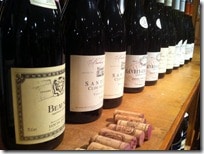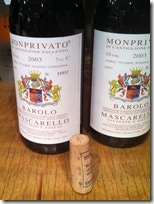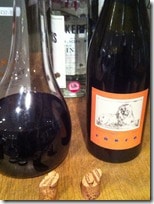 That there is a competitive streak among many men is hardly an earth-shattering observation. Wine tasting can be social, relaxed, erudite and many other things but it also can be competitive. Ben Llewellyn, MD of Caviste set up Thursday evening’s tasting as a competition – between two of Europe’s best established and prestigious regions. Burgundy and Piedmont just happen to be among my favourite regions. The tasting focused helpfully on the two most important grape varieties (with apologies to Chardonnay of course): Pinot Noir and Nebbiolo, from Burgundy and Piedmont, respectively. Ben has been talking for months about having secured some exceptional bottles of Nebbiolo without a thought for the cost, while Mark was assigned Burgundy within a budget … Not that there was any suggestion that this was a fix.
That there is a competitive streak among many men is hardly an earth-shattering observation. Wine tasting can be social, relaxed, erudite and many other things but it also can be competitive. Ben Llewellyn, MD of Caviste set up Thursday evening’s tasting as a competition – between two of Europe’s best established and prestigious regions. Burgundy and Piedmont just happen to be among my favourite regions. The tasting focused helpfully on the two most important grape varieties (with apologies to Chardonnay of course): Pinot Noir and Nebbiolo, from Burgundy and Piedmont, respectively. Ben has been talking for months about having secured some exceptional bottles of Nebbiolo without a thought for the cost, while Mark was assigned Burgundy within a budget … Not that there was any suggestion that this was a fix.
The idea was to taste six Pinot’s and six Nebbiolo side by side, by category – best wine by a cooperative, from a single vineyard, etc. This was an excellent approach, made better by the fact that the two varieties share some similarities: pale colour, red fruit (if raspberry v. cherry), medium to high acidity, producing full bodied wines in cool climates and, perhaps above all, ability to develop in very subtle ways with age. And there are only 225 miles between Beaune and Alba – plus the Alps! – so the climate is not that different. There is one huge difference of course: Pinot is only moderately astringent while Nebbiolo is the king of (pale) tannic wines!
 So how did the competition work out? Each wine was scored out of twenty and all the scores were totalled. This ensured a high level of participation on the evening, not to mention the occasional outbreak of barracking. Janet refused to score on ideological grounds, while I did the same for another reason which will become clear shortly. But the outcome was interesting. Despite the Burgundies being on the whole much cheaper, they only lost by the smallest margin – less than 2%. Why was this? Two guesses: people are much more familiar with Pinot Noir than with Nebbiolo and, further, the latter is seriously tannic, even in good examples. One could say that Ben needed much better, more expensive, wines than Mark to make it a contest!
So how did the competition work out? Each wine was scored out of twenty and all the scores were totalled. This ensured a high level of participation on the evening, not to mention the occasional outbreak of barracking. Janet refused to score on ideological grounds, while I did the same for another reason which will become clear shortly. But the outcome was interesting. Despite the Burgundies being on the whole much cheaper, they only lost by the smallest margin – less than 2%. Why was this? Two guesses: people are much more familiar with Pinot Noir than with Nebbiolo and, further, the latter is seriously tannic, even in good examples. One could say that Ben needed much better, more expensive, wines than Mark to make it a contest!
My aversion to scoring has nothing to do with disapproval of competitive sports. Scoring has its uses – but only in my view if the wines are in flights of similar wines. It makes no sense at all to try to score an off-dry ethereally light German Riesling on the same scale as a massive Californian Cabernet. It is difficult to score Pinot against Nebbiolo – even if we disregard the point that the samples of the former cost 50% less on average than those of the latter.
Let’s ask a completely different question: how good were the wines? There were many good wines in the line up and some really outstanding ones. G D Vajra’s village level Barolo 2005, £32, from an ordinary year, now has fine balsam, fruit,  the smell of cloves from old wood on the nose and fine complexity. Domaine Sylvie Esmonin Gevrey-Chambertin, Vielles Vignes, 2007, £35, is already singing – again great complexity in the the red and black fruit, superb. And, I am pleased to say, the great Barolo examples were just that: the 2003 from Monprivato Mascarello and the special treat – though sadly one bottle was corked – from Giorgio Rivetti. The name of this wine is so complicated it needs a sentence of its own: Giorgio Rivetti, La Spinetta Campè Vürsù, Barolo Campè, 2000, now just under £100. The family name is Rivetti (expert makers of Moscato), the company is called La Spinetta Campè and the wine is Barolo from the Campè vineyard near Grinzane Cavour, with the added name Vürsù – which I am guessing is going to be a bit of Piedmontese dialect as 30 minutes of research has not revealed anything! To all the usual Barolo qualities this adds rich, developed fruit, probably due to its very modern wine making process – in rotofermenters, which extract a great deal of fruit quickly, and then French barriques. Superb.
the smell of cloves from old wood on the nose and fine complexity. Domaine Sylvie Esmonin Gevrey-Chambertin, Vielles Vignes, 2007, £35, is already singing – again great complexity in the the red and black fruit, superb. And, I am pleased to say, the great Barolo examples were just that: the 2003 from Monprivato Mascarello and the special treat – though sadly one bottle was corked – from Giorgio Rivetti. The name of this wine is so complicated it needs a sentence of its own: Giorgio Rivetti, La Spinetta Campè Vürsù, Barolo Campè, 2000, now just under £100. The family name is Rivetti (expert makers of Moscato), the company is called La Spinetta Campè and the wine is Barolo from the Campè vineyard near Grinzane Cavour, with the added name Vürsù – which I am guessing is going to be a bit of Piedmontese dialect as 30 minutes of research has not revealed anything! To all the usual Barolo qualities this adds rich, developed fruit, probably due to its very modern wine making process – in rotofermenters, which extract a great deal of fruit quickly, and then French barriques. Superb.
If this is the standard of wines we can expect at Caviste’s future tastings, we will look forward to more – with or without the competitiveness!

